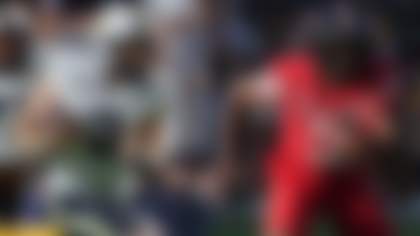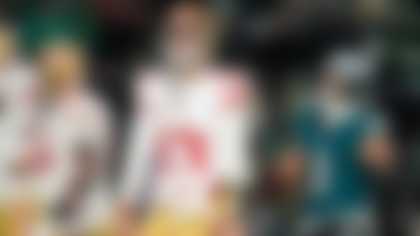I was in the airport the other day in Philadelphia when a nice older gentlemen strolled over to me and asked politely, "How come scouts in the NFL can't evaluate quarterbacks?"
"I am a retired policeman in Philly and don't think I have been wrong in my 30 years of watching college football. Once I watch them, I can tell instantly if he will be a star or just a wasted pick. Ask my wife here, she knows I am right."
I looked over to see a nice older lady violently nodding as if she was cued.
My next question to my new head of college scouting if I ever go back to working in the front office was, "What is your secret to all your self-proclaimed success?"
He answered quickly and simply. "I look them squarely in the eyes; the eyes tell it all."
The older gentleman's question is a fair one: How can teams continue to make so many major mistakes on quarterbacks? From Matt Leinart to JaMarcus Russell to Ryan Leaf, even all the way back to 1960 and first overall pick George Izo from Notre Dame, teams have repeatedly made mistakes picking the centerpiece of their franchise.
Have we not learned anything? Mistakes are a scout's best friend. Ask any scout to tell you his biggest mistake, and if he answers quickly he is a good scout. If he says he hasn't made a big one, then he's lying and stop talking to him. Mistakes are the best way for any scout or team to avoid similar pitfalls, but in the case of quarterbacks these mistakes keep repeating themselves year after year, decade after decade.
The latest Exhibit A is Leinart: Two-time national champion at USC, Heisman Trophy winner (not like that matters), set records at USC, and had he come out after his junior season he would have likely been the No. 1 overall pick of the 49ers instead of Alex Smith. However, Leinart returns to USC for his senior year and winds up sliding to the Cardinals at No. 10 in 2006. Euphoria breaks out in Arizona after decades of bad drafts. Have the Cards finally found their man? Now we know four years later the celebration was a bit premature.
Watching every game on a player is not the right thing to do, but rather watching the right games is what matters most.
So where did the Cards go wrong? Did they fail to give the Philly cop eye test? There are two fundamental rules in scouting. First: Never begin with the end in mind. And second: Past performance predicts future achievement.
The first one is essential, especially as it pertains to Leinart. If a scout walks into USC and begins to buy into the hype on Leinart, then the grade will reflect that hype and not the performance on the field. Talking to the coaching staff will only reinforce the positive perception. If a scout has a preconceived perception, then he will seek out people to support this perception.
One mistake most teams continue to make is allowing outside factors to determine a player's grade, both in a positive and negative way. If Leinart would have been evaluated under a more intense microscope, the flaws in Arizona would have been exposed. Suppose Leinart was not at USC; say he played at Idaho. Would his arm be considered a first-round arm? Would his accuracy? Would his work habits be good enough? You might answer no to all those questions and if Leinart did go to Idaho, would he have performed well enough to make them win a national championship (or BCS bowl)? I think you know the answer to that question.
The brand name developed at USC of Leinart made him a first rounder, not his overall skill set.
Leinart's past success on the field would surely satisfy one of the fundamental rules, but was that success based on his stellar play or more the team around him. Was Leinart carrying the team, or the team carrying him? The level of completion in college is a critical evaluation tool. Watching every game on a player is not the right thing to do, but rather watching the right games is what matters most. Leinart dominating Washington State, throwing for six touchdowns, that's nice, but it's not all that relevant. Playing well against Texas in the national championship game was.
It's easy to say now that, under further review, Leinart was never great when the competition increased. But unless we go back and watch those games again, it would be hard to make an accurate assessment.
The good scouting departments are watching Leinart again to learn from their mistakes, to gain a slight advantage on the competition. The teams or coaches (and I believe Ken Whisenhunt was one of them) who never bought in the hype of Leinart won't have to rewatch the tape, as four years earlier they already reached the conclusion the Cards did last week.
It takes a strong conviction of one's evaluation and the ability to tune out all the media attention to avoid these monumental mistakes. It takes confidence in your evaluation ability to stand and face the onslaught of popular opinion. It takes an understanding of the mistakes of the past and how to avoid them in the future. But it also takes the ability to peak into someone's heart and find out what really motivates them.
Do they play football for the perks, or for the love of the game? Tom Brady or Peyton Manning having endorsement deals is one thing; they already have Super Bowl championships under their belts. But for Leinart, or even Matt Ryan of the Falcons, or Joe Flacco of the Ravens, they have yet to prove themselves in the league. Leinart, when he first arrived at Arizona, was not a hard worker and was more interested in hot tub parties than studying the game. And this lack of dedication to the game cost him his career in Arizona.
Leinart will have a chance to reinvent himself in Houston, and most scouts and executives will take this time to learn how to avoid making the same mistake. But next time watching quarterbacks, instead of just looking them in the eye, take a moment to overlook the hype and the name of the school they're from. Instead, study the right games.
The only way to avoid the mistakes of the past is to make sure the past is studied intently and completely.



